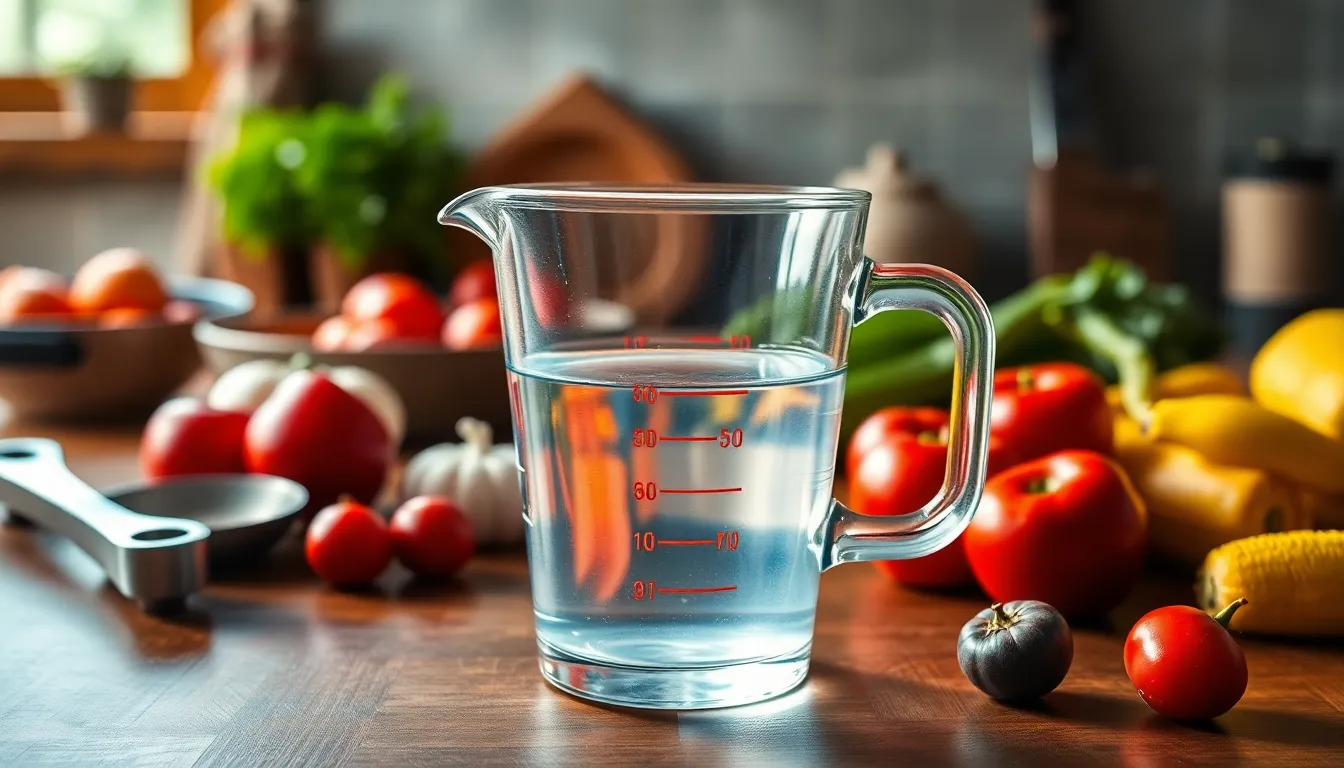Half a liter might seem like a simple measurement, but it plays a crucial role in everyday life. Whether it’s in cooking, drinking, or understanding liquid capacities, knowing how much half a liter is can make tasks easier and more precise. This measurement is commonly used across various contexts, from recipes to beverage containers, making it essential for anyone who wants to navigate their kitchen or enjoy their favorite drinks.
In the metric system, half a liter equals 500 milliliters, a volume that’s often encountered in bottles and measuring cups. Understanding this measurement not only helps in cooking but also aids in making informed choices when purchasing liquids. With this knowledge, anyone can confidently measure and convert liquid volumes, ensuring they get the right amount every time.
Table of Contents
ToggleUnderstanding Liquid Measurements
Liquid measurements, particularly for cooking and beverages, often rely on milliliters and liters.
- Metric System: In the metric system, one liter equals 1,000 milliliters. Consequently, half a liter amounts to 500 milliliters.
- Common Uses: Half a liter is a standard measurement in various contexts, such as bottled drinks and cooking recipes.
- Conversion Examples:
- 1 cup equals approximately 237 milliliters; thus, half a liter equals about 2.1 cups.
- 1 fluid ounce is about 29.57 milliliters, translating half a liter to about 16.9 fluid ounces.
Understanding these measurements ensures precision in both cooking and beverage consumption. This knowledge proves beneficial for anyone navigating recipes or managing hydration. Knowing how to measure liquid accurately helps avoid errors and enhances overall culinary experiences.
The Metric System Explained

The metric system serves as a standardized measurement system, widely used across the globe for its simplicity and ease of conversion. Understanding the components of this system, specifically liters, enhances one’s ability to work with liquid measurements.
What Is a Liter?
A liter is a metric unit of volume defined as the volume of one cubic decimeter. It equals 1,000 milliliters, making it a fundamental measurement in various applications, including cooking, scientific research, and everyday liquid consumption. Common items, such as bottled beverages, often feature their volume labeled in liters, making it intuitive for consumers.
Conversion Factors for Liters
Conversion factors simplify the process of translating liters into other volume measurements.
| Measurement | Equivalent |
|---|---|
| 1 liter | 1,000 milliliters |
| 1 liter | 2.11 cups |
| 1 liter | 33.8 fluid ounces |
| 0.5 liters | 500 milliliters |
| 0.5 liters | 1.06 pints |
Utilizing these conversion factors promotes accuracy when measuring liquids, ensuring users achieve the desired quantity in recipes or drink servings. Understanding these relationships facilitates precise cooking and effective beverage selections.
Practical Uses of Half a Liter
Half a liter serves various practical applications across everyday life, particularly in cooking, baking, and beverage consumption. Understanding this measurement helps individuals make accurate decisions in numerous contexts.
Common Everyday Examples
Half a liter frequently appears in daily scenarios, including beverage containers and recipe instructions. Common bottled drinks, such as water, soda, or juice, typically contain half a liter, making this measurement familiar. Many water bottles are labeled specifically for easy reference. For example, a standard bottled water size of 500 milliliters equates to half a liter. Additionally, coffee and tea servings often reference half a liter for larger mugs or pots, ensuring ample portions for sharing.
Cooking and Baking Measurements
Half a liter plays a significant role in cooking and baking, ensuring precision in measurements. Recipes often call for liquids such as milk, broth, or stock in this volume, simplifying ingredient preparation. For example, 500 milliliters of water is vital for cooking pasta or making soups.
Baking also benefits from half a liter as it helps measure liquids like water or milk in larger batches. When adapting recipes, knowing half a liter translates to approximately 2.1 cups or 16.9 fluid ounces enhances flexibility. This understanding supports accurate ingredient ratios, leading to successful culinary results.
How to Measure Half a Liter
Measuring half a liter accurately requires specific tools and techniques. Here are practical methods to achieve this measurement:
- Use a Liquid Measuring Cup
Use a liquid measuring cup marked in milliliters or liters. Fill the cup until the liquid reaches the 500-milliliter line.
- Employ a Kitchen Scale
Use a kitchen scale to measure water or other liquids. As water has a density close to 1 gram per milliliter, weigh 500 grams on the scale for half a liter.
- Utilize a Measuring Jug
Use a measuring jug with clear markings. Fill until the jug displays a measurement of 500 milliliters, confirming the liquid is at half a liter.
- Convert from Other Measurements
Convert from cups or fluid ounces. Since half a liter equals approximately 2.1 cups, measure out 2.1 cups or 16.9 fluid ounces as an alternative method.
- Check Markings on Bottles
Check pre-packaged beverage bottles. Many are labeled with milliliters or liters, allowing for easy measurement of half a liter.
By using these methods, individuals can measure half a liter effectively in various culinary and beverage scenarios, ensuring accurate results in recipes and servings.
Understanding half a liter is vital for anyone involved in cooking or beverage consumption. This measurement not only simplifies the process of following recipes but also aids in making informed choices when purchasing drinks.
By grasping the equivalence of half a liter to 500 milliliters or approximately 2.1 cups, individuals can enhance their culinary skills and ensure accuracy in their measurements.
Utilizing the various methods for measuring liquids effectively ensures that they achieve the desired outcomes in their cooking and baking endeavors. With this knowledge, navigating the metric system becomes a straightforward task, allowing for greater confidence in the kitchen.


